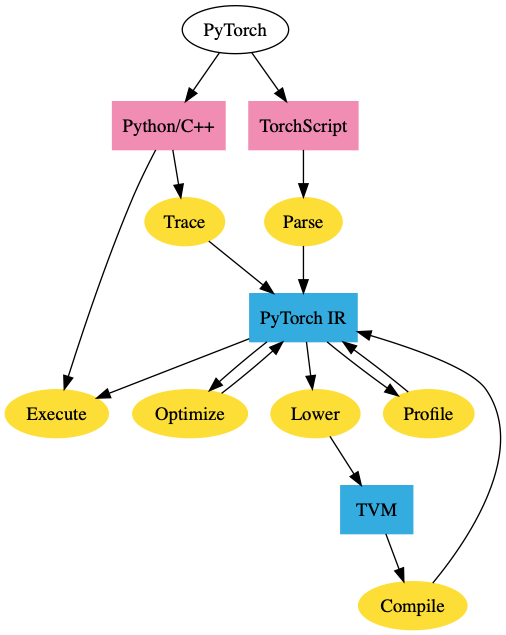pytorch/tvm

TVM integration into PyTorch
| repo name | pytorch/tvm |
| repo link | https://github.com/pytorch/tvm |
| homepage | |
| language | C++ |
| size (curr.) | 600 kB |
| stars (curr.) | 326 |
| created | 2019-03-28 |
| license | |
Pytorch TVM Extension
Build
Install the latest Nightly build of PyTorch.
Then, build this repo
# Make sure the right llvm-config is in your PATH
python setup.py install
Test
python setup.py test
Usage
This package transparently hooks into PyTorch’s JIT, so the same tooling is applicable (see @torch.jit.script, torch.jit.trace and graph_for). See below for an example.
import torch
import torch_tvm
torch_tvm.enable()
# The following function will be compiled with TVM
@torch.jit.script
def my_func(a, b, c):
return a * b + c
To disable the JIT hooks, use torch_tvm.disable().
Code Layout
register.cpp: Sets up pybind bindings and invokes the registration of a TVM backend.compiler.{h,cpp}: Main logic to compile a PyTorch JIT graph with TVM.operators.{h,cpp}: Location of mapping from JIT IR to TVM operators.

FAQ
How do I configure TVM compilation?
All options are available as keyword arguments in the enable function exposed by torch_tvm.
The optimization level, device type, device and host compilation targets are all exposed directly from TVM.
torch_tvm.enable(
opt_level=3,
device_type="cpu",
device="llvm",
host="llvm")
How do I register a new TVM operator?
First, ensure the operator is registered with Relay.
Then, register a map from PyTorch symbols to a Relay CallNode with RegisterTVMOperator.
This can be done in any compilation unit provided it is linked into the final torch_tvm library.
See torch_tvm/operators.cpp for examples.
RegisterTVMOperator reg_relu({
{Symbol::fromQualString("aten::relu"),
[](Node* node, tvm::Array<tvm::relay::Expr> inputs) {
auto op = tvm::relay::Op::Get("nn.relu");
return tvm::relay::CallNode::make(op, inputs, tvm::Attrs(), {});
}},
});
How do I extract the Relay expression associated with a PyTorch Graph?
If the PyTorch function can be fully converted to Relay, it is possible to extract the expression itself
using torch_tvm.to_relay(func, inputs). Example inputs must be passed in to calculate type information.
def add(a, b, c):
return a + b + c
# via tracing
relay_graph = torch_tvm.to_relay(add, inputs)
@torch.jit.script
def mul(a, b, c):
return a * b * c
# via script
relay_graph = torch_tvm.to_relay(mul, inputs)
Note that not all functions can be converted to Relay in their entirety and will raise exceptions if expression extraction is attempted. To solve this isse, simply refactor the function.
v0.1 Roadmap
Below, in order, is a prioritized list of tasks for this repository.
- End to end build and runtime
- Operator translation
- Add
- Multiply
- Convolution
- BatchNorm
- Relu
- AveragePool
- MaxPool
- Linear
- Reshape
- AdaptiveAveragePool
- Tooling
- Model coverage checks
- Benchmarks for master
- User exposed configurations
- Backend selection (CPU/Cuda/OpenCL)
- Optimization level
- Custom TVM operator registration
- Enable Python/C++ mechanism to use custom TVM operators and schedules
- Enable Relay op registration
- Bail-out mechanism
- When TVM cannot compile a subgraph, invoke PyTorch JIT fallback
- Extract Relay expression
- Enable exposure of ops registered in eager mode under
torch.ops.tvm.*
v0.2 Plan
- View support
- Zero copy
set_input - Subsystem integration
- Threadpool integration
- Allocator integration
tvm/include/tvm/runtime/device_api.h
- Distributed communication
- IR integration
- Control flow
- Aliasing
- Operators
- transpose
- chunk
- repeat
- cat
- unsqueeze
- slice
- softmax
- bmm
- layernorm






